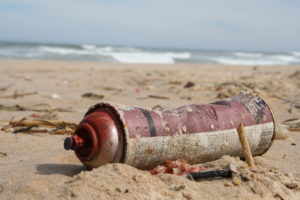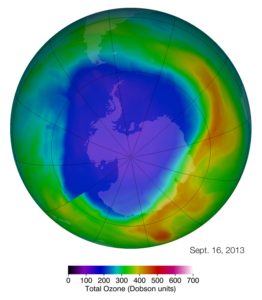Sweden became the first country to regulate the use of chloroflourocarbons (CFCs) when it banned their use in aerosols on January 23, 1978. Other countries followed, including the U.S., leading to the eventual worldwide ban known as the Montreal Protocol.

Like so many chemicals produced after World War II, CFCs seemed like miracle compounds. They were cheap and easy to make, and were inert, non-toxic and non-flammable. They were widely used as propellants in aerosol spray cans, as plastic foams sprayed for insulation, as solvents for cleaning electrical components, and as refrigerants in air conditioning units for buildings and vehicles. Their use grew rapidly throughout the post-war era of booming prosperity.
But another outcome of post-war technology proved their undoing. By the 1970s, scientists developed remote sensing tools that could detect chemicals in the stratosphere. Scientists discovered that various forms of CFCs were present at high altitudes and that the compound’s presence reduced ozone concentrations. Lower ozone concentrations increased UV radiation reaching the earth, resulting in increased incidence of skin cancer and cataracts in humans. Even more important, CFCs remained in the atmosphere for up to a century before degrading.

These worrying findings began a series of decisions by nations around the world, starting with Sweden in January, 1978. Canada, Norway and Denmark quickly enacted their own bans. The U.S. acted to regulate “non-essential” uses of CFCs in March, 1978, to be implemented that December. Other European nations followed suit, and in 1980, the European Economic Community (now the EU) placed limits of CFC production and use.
Ongoing studies showed that ozone losses in the stratosphere were worse than thought and that an “ozone hole” had developed over the Antarctic. As worldwide concern over ozone depletion grew, the world agreed to a strategy for controlling what are now called ODS—ozone-depleting substances. The Montreal Protocol, as it is known, came into force on January 1, 1989.
Kofi Annan, former UN Secretary-General, said, “Perhaps the single most successful international environmental agreement to date has been the Montreal Protocol.” In a report in 2023, the UN estimated that 99% of ozone-depleting chemicals have been eliminated from the earth. The U.S. Environmental Protection Agency cited in 2017 that 45 million cases of cataracts and 280 million cases of skin cancer have been avoided—and that 1.6 million American lives have been saved because of the regulation of ODS. In total, the regulation of these chemical compounds has produced $4.2 trillion in societal health benefits in the United States. The ozone hole is declining regularly, and EPA estimates that ozone levels in the atmosphere will return to pre-1980 levels by 2040 in most places, but it will take another 20 years for ozone to return fully to the Arctic and Antarctic atmospheres..
References:
Byrd, Deborah. 2015. This date in science: Sweden goes first to ban aerosol sprays. EarthSky, January 23, 2015. Available at: http://earthsky.org/earth/this-date-in-science-sweden-goes-first-to-ban-aerosol-sprays. Accessed January 23, 2018.
Diaz, Jaclyn. 2023. The ozone layer is on track to recover in the coming decades, the United Nations says. NPR, Januiary 10, 2023. Available at: https://www.npr.org/2023/01/10/1147977166/ozone-layer-recovery-united-nations-report. Accessed January 10, 2023.
Morrisette, Peter M. 1989. The Evolution of Policy Responses to Stratospheric Ozone Depletion. Natural Resources Journal 29:793-820. Available at: http://www.ciesin.org/docs/003-006/003-006.html. Accessed January 23, 2018.
US Environmental Protection Agency. 2017. Stratospheric Ozone Protection—30 Years of Progress and Achievements. Available at: https://www.epa.gov/sites/production/files/2017-11/documents/mp30_report_final_12.pdf. Accessed January 23, 2018.
